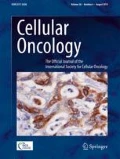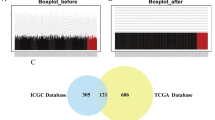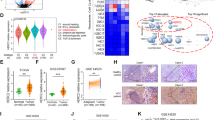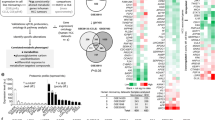Abstract
Background
Hepatocellular carcinoma (HCC) is the fifth most common cancer and the third leading cause of cancer death worldwide. It is a heterogeneous disorder and >80 % of the tumors develop in patients with liver cirrhosis, resulting from chronic inflammation and/or fibrosis. Here, we set out to identify novel targets for HCC therapy and to define a subgroup of patients that might benefit most from it.
Methods
Cellular pathway activation profiling of 45 transcription factors in a HCC-derived cell line (HEP3B), in vitro analysis of NFκB reporter activity in additional HCC-derived cell lines and pathway-focused integrative analyses of publicly available primary HCC-derived expression profiling data (GSE6764, GSE9843, E-TABM-36 and E-TABM-292) were employed to reveal a role of NFκB in HCC development. In order to identify potential targeting agents, a luciferase-based NFκB reporter screening assay was established in HEP3B cells. After screening of a drug library through this assay, a potent NFκB pathway inhibitor was identified and characterized using an array of additional in vitro assays.
Results
Using cellular pathway activation profiling, we found a high activation of NFκB-mediated signaling in HCC-derived cell lines and in primary HCC tumors. Through NFκB inhibitor screening we observed a highly efficacious NFκB pathway inhibitory potential of ornithogalum in HCC-derived HEP3B cells. Although its active component still remains to be defined, ornithogalum has been found to inhibit endoplasmic reticulum (ER) and oxidative stress responses. ER stress, oxidative stress and NFκB signaling were found to be enhanced in a subset of HCCs, as well as in (precancerous) liver cirrhosis tissues.
Conclusion
From our data we conclude that NFκB signaling is activated in precancerous cirrhosis tissues and in a subset of HCCs. We found that ornithogalum exhibits NFκB targeting and stress relieving activities. NFκB inhibitors, including the active component of ornithogalum, may serve as putative preventive and targeted therapeutic agents for at least a subset of HCCs in which the NFκB pathway is activated. These latter notions require further investigation in a translational context.






Similar content being viewed by others
References
J. Ferlay, H. R. Shin, F. Bray, D. Forman, C. Mathers, D. M. Parkin, Estimates of worldwide burden of cancer in 2008: GLOBOCAN 2008. Int. J. Cancer 127, 2893–2917 (2010)
L. Zender, M. S. Spector, W. Xue, P. Flemming, C. Cordon-Cardo, J. Silke, S. T. Fan, J. M. Luk, M. Wigler, G. J. Hannon, D. Mu, R. Lucito, S. Powers, S. W. Lowe, Identification and validation of oncogenes in liver cancer using an integrative oncogenomic approach. Cell 125, 1253–1267 (2006)
N. Nishida, A. Goel, Genetic and epigenetic signatures in human hepatocellular carcinoma: a systematic review. Curr Genomics 12, 130–137 (2011)
R. Saeki, H. Nagai, S. Kaneko, M. Unoura, N. Yamanaka, E. Okamoto, K. Kobayashi, K. Matsubara, Intratumoral genomic heterogeneity in human hepatocellular carcinoma detected by restriction landmark genomic scanning. J. Hepatol. 33, 99–105 (2000)
L. A. D'Alessandro, R. Meyer, U. Klingmüller, Hepatocellular carcinoma: a systems biology perspective. Front. Physiol. 4, 28 (2013)
S. Fatima, N. P. Lee, J. M. Luk, Dickkopfs and Wnt/β-catenin signalling in liver cancer. World. J. Clin. Oncol. 2, 311–325 (2011)
J. M. Llovet, J. Bruix, Molecular targeted therapies in hepatocellular carcinoma. Hepatology 48, 1312–1327 (2008)
Y. Totoki, K. Tatsuno, S. Yamamoto, Y. Arai, F. Hosoda, S. Ishikawa, S. Tsutsumi, K. Sonoda, H. Totsuka, T. Shirakihara, H. Sakamoto, L. Wang, H. Ojimo, K. Shimada, T. Kosuge, T. Okusaka, K. Kato, J. Kusuda, T. Yoshida, H. Aburatani, T. Shibata, High-resolution characterization of a hepatocellular carcinoma genome. Nat. Genet. 43, 464–469 (2011)
S. I. Grivennikov, M. Karin, Inflammatory cytokines in cancer: tumour necrosis factor and interleukin 6 take the stage. Ann. Rheum. Dis. 70, i104–i108 (2011)
G. Fattovich, T. Stroffolini, I. Zagni, F. Donato, Hepatocellular carcinoma in cirrhosis: incidence and risk factors. Gastroenterology 127, S35–S50 (2004)
M. Karin, A. Lin, NF-kappaB at the crossroads of life and death. Nat. Immunol. 3, 221–227 (2002)
K. Vazquez-Santillan, J. Melendez-Zajgla, L. Jimenez-Hernandez, G. Martinez-Ruiz, V. Maldonado, NF-κB signaling in cancer stem cells: a promising therapeutic target? Cell. Oncol. 38, 327–339 (2015)
B. B. Aggarwal, A. Bhardwaj, R. S. Aggarwal, N. P. Seeram, S. Shishodia, Y. Takada, Role of resveratrol in prevention and therapy of cancer: preclinical and clinical studies. Anticancer Res. 24, 2783–2840 (2004)
N. Chainani-Wu, Safety and anti-inflammatory activity of curcumin: a component of tumeric (Curcuma longa. J. Altern. Complement. Med. 9, 161–168 (2003)
L. Fredriksson, B. Herpers, G. Benedetti, Q. Matadin, J. C. Puigvert, H. de Bont, S. Dragovic, N. P. Vermeulen, J. N. Commandeur, E. Danen, M. de Graauw, B. van de Water, Diclofenac inhibits tumor necrosis factor-α-induced nuclear factor-κB activation causing synergistic hepatocyte apoptosis. Hepatology 53, 2027–2041 (2011)
S. C. Miller, R. Huang, S. Sakamuru, S. J. Shukla, M. S. Attene-Ramos, P. Shinn, D. Van Leer, W. Leister, C. P. Austin, M. Xia, Identification of known drugs that act as inhibitors of NF-kappaB signaling and their mechanism of action. Biochem. Pharmacol. 79, 1272–1280 (2010)
S. Shishodia, D. Koul, B. B. Aggarwal, Cyclooxygenase (COX)-2 inhibitor celecoxib abrogates TNF-induced NF-kappa B activation through inhibition of activation of I kappa B alpha kinase and Akt in human non-small cell lung carcinoma: correlation with suppression of COX-2 synthesis. J. Immunol. 173, 2011–2022 (2004)
X. Yao, J. Huang, H. Zhong, N. Shen, R. Faggioni, M. Fung, Y. Yao, Targeting interleukin-6 in inflammatory autoimmune diseases and cancers. Pharmacol. Ther. 141, 125–139 (2014)
S. W. Tas, M. J. Vervoordeldonk, P. P. Tak, Gene therapy targeting nuclear factor-κB: towards clinical application in inflammatory diseases and cancer. Curr Gene Ther 9, 160–170 (2009)
J. R. Nevins, Pathway-based classification of lung cancer: a strategy to guide therapeutic selection. Proc. Am. Thorac. Soc. 8, 180–182 (2011)
P. N. Verma, I. Vaid, Encyclopaedia of Homeopathic Pharmacopoeia, Vol. IB (Jain Publishers, New Delhi, India, 2002), p. 1864
B. W. Dyer, F. A. Ferrer, D. K. Klinedinst, R. Rodriguez, A noncommercial dual luciferase enzyme assay system for reporter gene analysis. Anal. Biochem. 282, 158–161 (2000)
T. Mosmann, Rapid colorimetric assay for cellular growth and survival: application to proliferation and cytotoxicity assays. J. Immunol. Methods 65, 55–63 (1983)
A. Subramanian, P. Tamayo, V. K. Mootha, S. Mukherjee, B. L. Ebert, M. A. Gillette, A. Paulovich, S. L. Pomeroy, T. R. Golub, E. S. Lander, J. P. Mesirov, Gene set enrichment analysis: a knowledge-based approach for interpreting genome-wide expression profiles. Proc. Natl. Acad. Sci. U. S. A. 102, 15545–15550 (2005)
J. Lamb, E. D. Crawford, D. Peck, J. W. Modell, I. C. Blat, M. J. Wrobel, J. Lerner, J. P. Brunet, A. Subramanian, K. N. Ross, M. Reich, H. Hieronymus, G. Wei, S. A. Armstrong, S. J. Haggarty, P. A. Clemons, R. Wei, S. A. Carr, E. S. Lander, T. R. Golub, The connectivity map: using gene-expression signatures to connect small molecules, genes, and disease. Science 313, 1929–1935 (2006)
C. Li, W. H. Wong, Model-based analysis of oligonucleotide arrays: expression index computation and outlier detection. Proc. Natl. Acad. Sci. U. S. A. 98, 31–36 (2001)
J. Boelens, S. Lust, F. Offner, M. E. Bracke, B. W. Vanhoecke, The endoplasmic reticulum: a target for new anticancer drugs. In Vivo 21, 215–226 (2007)
A. Shibata, T. Nagaya, T. Imai, H. Funahashi, A. Nakao, H. Seo, Inhibition of NF-κB activity decreases the VEGF mRNA expression in MDA-MB-231 breast cancer cells. Breast Cancer Res. Treat. 73, 237–243 (2002)
D. Hanahan, R. A. Weinberg, The hallmarks of cancer. Cell 100, 57–70 (2000)
A. Geurts van Kessel, The cancer genome: from structure to function. Cell. Oncol. 37, 155–165 (2014)
F. Colotta, P. Allavena, A. Sica, C. Garlanda, A. Mantovani, Cancer-related inflammation, the seventh hallmark of cancer: links to genetic instability. Carcinogenesis 30, 1073–1081 (2009)
S. Lüth, J. Schrader, S. Zander, A. Carambia, J. Buchkremer, S. Huber, K. Reifenberg, K. Yamamura, P. Schirmacher, A. W. Lohse, J. Herkel, Chronic inflammatory IFN-γ signaling suppresses hepatocarcinogenesis in mice by sensitizing hepatocytes for apoptosis. Cancer Res. 71, 3763–3771 (2011)
J. F. Rossi, S. Negrier, N. D. James, I. Kocak, R. Hawkins, H. Davis, U. Prabhakar, X. Qin, P. Mulders, B. Berns, A phase I/II study of siltuximab (CNTO 328), an anti-interleukin-6 monoclonal antibody, in metastatic renal cell cancer. Br. J. Cancer 103, 1154–1162 (2010)
F. Wang, P. Arun, J. Friedman, Z. Chen, C. Van Waes, Current and potential inflammation targeted therapies in head and neck cancer. Curr. Opin. Pharmacol. 9, 389–395 (2009)
S. Maeda, H. Kamata, J. L. Luo, H. Leffert, M. Karin, IKKβ couples hepatocyte death to cytokine-driven compensatory proliferation that promotes chemical hepatocarcinogenesis. Cell 121, 977–990 (2005)
P. J. Wysocki, Targeted therapy of hepatocellular cancer. Expert Opin Investig Drugs 19, 265–274 (2010)
W. Yeo, T. S. Mok, B. Zee, T. W. Leung, P. B. Lai, W. Y. Lau, J. Koh, F. K. Mo, S. C. Yu, A. T. Chan, P. Hui, B. Ma, K. C. Lam, W. M. Ho, H. T. Wong, A. Tang, P. J. Johnson, A randomized phase III study of doxorubicin versus cisplatin/interferon α-2b/doxorubicin/fluorouracil (PIAF) combination chemotherapy for unresectable hepatocellular carcinoma. J. Natl. Cancer Inst. 97, 1532–1538 (2005)
A. R. Baudy, N. Saxena, H. Gordish, E. P. Hoffman, K. Nagaraju, A robust in vitro screening assay to identify NF-κB inhibitors for inflammatory muscle diseases. Int. Immunopharmacol. 9, 1209–1214 (2009)
Y. Zhou, C. Garcia-Prieto, D. A. Carney, R. H. Xu, H. Pelicano, Y. Kang, W. Yu, C. Lou, S. Kondo, J. Liu, D. M. Harris, Z. Estrov, M. J. Keating, Z. Jin, P. Huang, OSW-1: a natural compound with potent anticancer activity and a novel mechanism of action. J. Natl. Cancer Inst. 97, 1781–1785 (2005)
V. Yadav, S. Sultana, J. Yadav, N. Saini, Gatifloxacin induces S and G2-phase cell cycle arrest in pancreatic cancer cells via p21/p27/p53. PLoS One 7, e47796 (2012)
D. Lavelle, J. DeSimone, M. Hankewych, T. Kousnetzova, Y. H. Chen, Decitabine induces cell cycle arrest at the G1 phase via p21(WAF1) and the G2/M phase via the p38 MAP kinase pathway. Leuk. Res. 27, 999–1007 (2003)
T. Fujimoto, M. Onda, H. Nagai, T. Nagahata, K. Ogawa, M. Emi, Upregulation and overexpression of human X-box binding protein 1 (hXBP-1) gene in primary breast cancers. Breast Cancer 10, 301–306 (2003)
C. Jamora, G. Dennert, A. S. Lee, Inhibition of tumor progression by suppression of stress protein GRP78/BiP induction in fibrosarcoma B/C10ME. Proc. Natl. Acad. Sci. U. S. A. 93, 7690–7694 (1996)
M. Shuda, N. Kondoh, N. Imazeki, K. Tanaka, T. Okada, K. Mori, A. Hada, M. Arai, T. Wakatsuki, O. Matsubara, N. Yamamoto, M. Yamamoto, Activation of the ATF6, XBP1 and grp78 genes in human hepatocellular carcinoma: a possible involvement of the ER stress pathway in hepatocarcinogenesis. J. Hepatol. 38, 605–614 (2003)
G. S. Hotamisligil, Endoplasmic reticulum stress and the inflammatory basis of me4tabolic disease. Cell 140, 900–917 (2010)
C. Garcia-Prieto, K. B. R. Ahmed, Z. Chen, Y. Zhou, N. Hammoudi, Y. Kang, C. Lou, Y. Mei, Z. Jin, P. Huang, Effective killing of leukemia cells by the natural product OSW-1 through disruption of cellular calcium homeostasis. J. Biol. Chem. 288, 3240–3250 (2013)
J. Jin, X. Jin, C. Qian, Y. Ruan, H. Jiang, Signaling network of OSW-1-induced apoptosis and necroptosis in hepatocellular carcinoma. Mol. Med. Rep. 7, 1646–1650 (2013)
Y. Inami, S. Waguri, A. Sakamoto, T. Kouno, K. Nakada, O. Hino, S. Watanabe, J. Ando, M. Iwadate, M. Yamamoto, M. S. Lee, K. Tanaka, M. Komatsu, Persistent activation of Nrf2 through p62 in hepatocellular carcinoma cells. J. Cell Biol. 193, 275–284 (2011)
J. M. Luk, C. T. Lam, A. F. Siu, B. Y. Lam, I. O. Ng, M. Y. Hu, C. M. Che, S. T. Fan, Proteomic profiling of hepatocellular carcinoma in Chinese cohort reveals heat-shock proteins (Hsp27, Hsp70, GRP78) up-regulation and their associated prognostic values. Proteomics 6, 1049–1057 (2006)
S. Derks, B. Diosdado, Personalized cancer medicine: next steps in the genomic era. Cell. Oncol. 38, 1–2 (2015)
Acknowledgments
This work was supported by the Department of Atomic Energy, Government of India, through research grant No. 6/6/2008/R&D-II-230R and the Department of Biotechnology, Government of India through research grant BT/PR4500/PID/6/676/2012 to Dr. Kumaresan Ganesan, Madurai Kamaraj University. We acknowledge the award of CSIR-NET fellowship to Vignesh Ramesh. Instrumentation support of the UGC-CEGS, UGC-CAS, DBT-IPLS, DST-PURSE and UGC-NRCBS program and the central facilities of the School of Biological Sciences, Madurai Kamaraj University, are also acknowledged. The authors thank Dr. Piyush Trivedi for providing the drug screening library and Mrs. Jaishree, Publication Division, IIT-Madras, for editorial assistance.
Author information
Authors and Affiliations
Corresponding author
Ethics declarations
Conflict of interest
The authors declare that they have no conflict of interest
Rights and permissions
About this article
Cite this article
Ramesh, V., Selvarasu, K., Pandian, J. et al. NFκB activation demarcates a subset of hepatocellular carcinoma patients for targeted therapy. Cell Oncol. 39, 523–536 (2016). https://doi.org/10.1007/s13402-016-0294-4
Accepted:
Published:
Issue Date:
DOI: https://doi.org/10.1007/s13402-016-0294-4




